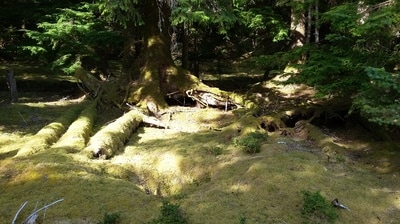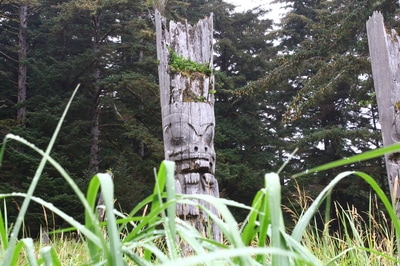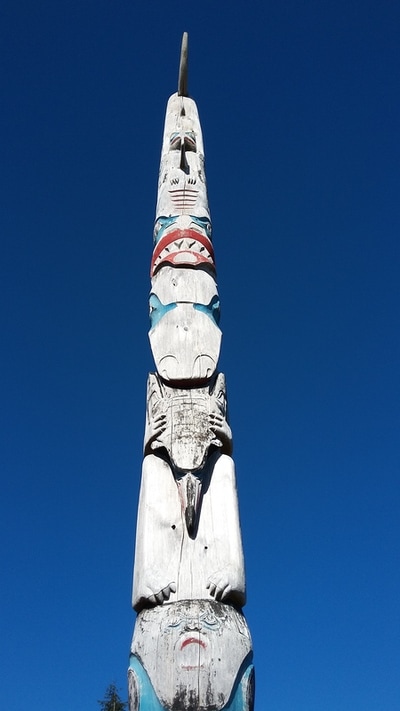A New Jersey couple, known bargain hunters, were the basket’s buyers. No doubt, they will take good care of it. Nonetheless, although it’s awkward to admit, considering what has long been my reportorial beat, I habitually convert prices into what more practical things the same money might buy: college tuition, years of groceries for a family of four, etcetera.
Understandably, I am more willing to acknowledge that I also silently cheer whenever a public institution manages to outspend the private collectors. That’s because a museum purchase invariably means it will be shared by all of us. So imagine how I surprised myself when on a Sierra Club trip to British Columbia last summer, cruising around Haida Gwaii, I began to question how I felt even about museum purchases, at least where certain ethnographic material from the Pacific Northwest is concerned. In Haida Gwaii I realized I didn’t even want a museum to have what I was seeing — specifically, the Haida people’s magnificent, monumental, carved-cedar totem poles.
At the beginning of my week-long trip to this exquisitely remote archipelago off the coast of Vancouver Island, I was emphatically in favor of what might be called the poles’ “museumification.” By mid-trip, after learning about the poles’ meanings and purposes, I modified that stance. (“Well, a few definitely should be in public institutions. The rest, okay, they can stay here.”) By the trip’s end, having undergone a true education, I had made a complete about-face, thinking that all of them should stay exactly put, in the beautiful, mystical cedar forests of Haida Gwaii.
One may legitimately argue that only the Haidas’ opinions matter here. Who am I anyway to weigh in on this subject? But if we sincerely believe we are all one family, that thinking goes right out the window or, to use a more suitable metaphor, over the side of the boat with the scraps from the kitchen. So here is my story.
Awakening on that boat each morning, seeing eagles in the sky and, with luck, a black bear scavenging on the shoreline, I found myself in the perfect situation for my new attitude to take form. I also had the perfect teachers. On visits to Skedans Village, Hot Springs Island, Rose Harbour, Scudder Point, and Windy Bay, our guides were Haida, who are called watchmen, because they watch over this land of their ancestors. These otherwise regular guys, with jobs on the mainland in the cold months of the year, led us along paths carefully delineated by lines of white clam shells. We were instructed not to step beyond them into the forest, which is populated by their ancestors’ spirits.
In each place we saw remnants of the Haidas’ summer houses and the poles that once soared above them. These communities had been abandoned starting in the mid-19th century, after European diseases devastated them. Although we could still see their carved totems — eagle, bear, raven, killer whale, frog, beaver, and so on — all of the poles were in various states of decay. The ones that faced the water were gray, weathered, like the cedar shingles I customarily see on houses on Cape Cod and elsewhere in New England. Deeper inland, where it was damp and shady, they were covered in furry green moss. What is more, while some of the poles were still upright, others were leaning, and still others had toppled over. It seemed a shame; at least it did at first.
In the late 20th century, some poles were removed to museums on the mainland, where the idea was that they would be studied, exhibited, and preserved. Prominently, Haida artist Bill Reid (1920-1998) orchestrated the removal of examples to a Vancouver museum. Surely someone of his heritage and profession had given ample thought to such an enterprise and its consequences. Surely he could not have been wrong.
Museums, however, have always been problematic for First Nations people. They are all too keenly aware that many ethnographic objects were originally acquired in questionable ways. “If there is any people on earth whose lives are more tangled up with museums than we are, God help them,” the sharp-witted Paul Chaat Smith wrote in one of the essays collected in his eye-opening book Everything You Know About Indians is Wrong. (And yes, as he has written elsewhere, he does see the irony in his current position as associate curator at Washington, D.C.’s National Museum of the American Indian.)
Reid is buried on one of the islands we visited in Haida Gwaii. His bronze sculpture Spirit of Haida Gwaii: The Jade Canoe is on view at the Vancouver airport. Considering what I have learned about his life, accomplishments, philosophy, politics, and persona, it’s hard not to compare him with another man who became passionate about Native Americana. He was George Gustav Heye (1874–1957), an investment banker whose family money came from petroleum and who founded the Museum of the American Indian in New York City in 1916. Standing 6’3” and weighing in the vicinity of 300 lbs., Heye smoked big cigars while driving his limousine 90 miles an hour (his chauffeur having been relegated to the passenger seat, as the story goes) in cross-country searches for objects for his collection. In the antiques trade we call that the “Hoovering" style of collecting, as in Hoover vacuum cleaner. By 1990 when Heye’s museum became part of the Smithsonian Institution, the inventory list was almost a million items long, making it the largest assemblage of Native American artifacts gathered by a single individual.
There’s no denying that much of what Heye and others collected would otherwise have been lost. That’s why you may think, as I once did, that it’s important for institutions to bring the poles inside. Otherwise, dust unto dust. Right? Well, here’s the point that was initially lost on me. As I learned from the watchmen, the poles’ seeming state of neglect is not neglect at all. Even if the Haida hadn’t been ravaged by the epidemics, the way I was seeing the poles was exactly as those who carved them and raised them up in great celebrations had designed them to be seen at this stage in the poles’ lives. They were meant to dissolve back into the earth, replenishing it. From the fallen ones, new trees sprout and grow straight up out of them: a complete, interdependent, ecological system. In fact, some of the poles are literal mortuaries, containing the remains of the dead. Others are memorial poles, meant to honor people buried elsewhere, but they, too, were intended, just like life itself, to be only temporary. Seen from that new perspective, suddenly the furry green moss, especially in the sunshine, looked luminous to me, life-giving.
As crucial an element in the Haida ecosystem as the cedar forest is the region’s salmon. Not coincidentally, the $63,250 Tlinglit basket was made to carry salmon,and seven such fish were woven into the geometric pattern that ringed it. Like the Haida, the Tlingit people depended on the salmon for sustenance. They still do. Indeed, that salmon culture was on display at a simply amazing lunch of local foods I enjoyed on this trip.
They were all made by a Haida woman, Roberta Olson, whose business is called Keenawaii's Kitchen. There were fresh and smoked salmon dishes of course, but also a dried version, called gilgii, and a medicinal fish oil a few drops of which Roberta offered as an addition to any of the other dishes of the meal. There were also things like a gorgeous salad of tomatoes and blueberries — the work of an obvious artist. Only later did I find the modest Roberta on the Internet, where I discovered that she and her cuisine are quite famous, so much so that, a month after we were there, she cooked lunch for Prince William and Princess Kate Middleton, serving it to them in the same space where we had eaten — her modest home.
The royal couple’s visit was part of Britain’s ongoing historic reconciliation with the Haida Nation. There is still more work to be done. That part of the world used to be known as the Queen Charlotte Islands. The name was officially changed to Haida Gwaii in 2009, although it’s a good bet that many non-Haida persist in calling it by its former appellation.
About four months after I returned home from Haida Gwaii, I went to the British Museum in London. I hadn’t gotten much past the front door when, lo and behold, I saw two poles literally towering above the museum goers in what is called the Grand Court. I made a beeline for them, as if to greet old friends. I found, however, that seeing them so far removed from their original context made me sad.
One was Haida, the other Nisga’a. “Raising poles involved tens or even hundreds of people,” the signage for the Haida example said. If I hadn’t known better, I would have taken the past tense of that statement as fact. But the truth is, new poles are being carved and raised by Haida today. I had seen a brightly painted, newly raised one at the Haida Heritage Center in Skidegate. And I had heard about another going up in Masset. One of the British Museum’s poles had come from a spot very close to that village, Kayang, in 1903. At the time, the signage said, Kayang had already been devastated by the introduced diseases and abandoned. I later looked this pole up on the museum’s website. It was acquired from Charles Frederick Newcombe (1851-1924), a “physician, botanist and ethnographer collector” who in the 1880s emigrated to Oregon, then Victoria, with his family. Elsewhere on the web, I learned that Newcombe started to collect Haida artifacts for multiple museums in order to “preserve” them. These include museums in the U.S. as well as Britain and Australia.
The Nisga’a pole, acquired by the British Museum in 1933, was initially bought by Canadian ethnographer Marius Barbeau the previous year. According to the museum’s website, the receipt for it reads: “[To] Smith and his clan For totem pole of Eagle-Beaver, their property, which they cede in complete clan agreement without further claim (assuming responsibility of division of price between themselves) to M. Barbeau for his disposal according to authority received. Received payment in full (signed) William Smith his mark. (witness) Albert Allen. $310.” I read elsewhere on the web that Barbeau (1883-1969) was an early proponent of recognizing totem poles as art but that he believed they were a post-contact development, a theory that has been thoroughly quashed.
The two poles in the Great Court have been on permanent display there since 2008. As I finished writing this, I learned that the museum has opened a new, complementary exhibit, “Where the Thunderbird Lives: Cultural Resilience on the Northwest Coast of North America.” Scheduled to be on view through August 27, 2017, it the first of its kind at this institution. “These people have created some of the most extraordinary carving and weaving traditions in the world,” says the press release, “and many of these are displayed for the first time in the British Museum’s history.”
I have to acknowledge that I want to see this exhibit. If I were going to London between now and then, I would make it my business to. It’s also undeniably true that without the museum component many people would have to travel, as I did, a great distance to see the poles — not an easy or inexpensive thing to do. Alternatively, we would have to rely on other people’s photography, and to be sure, photography does have its limits. When I got back to my London hotel room after my visit to the British Museum that day, I looked at the photos I had taken with my phone all over the building. Everything had come out fine, with the sole exception of my images of the poles. They simply weren’t there. Who can explain it? So odd. So uncanny. I was reminded that the watchmen took special delight in telling us the myths that the totems on the poles represent. Some are heroes, some villains, and not a few are tricksters capable of supernatural feats. I’m not someone who usually subscribes to such things, but in this case, I must chalk up the disappeared photos to the spirit of the Haida.



 RSS Feed
RSS Feed
